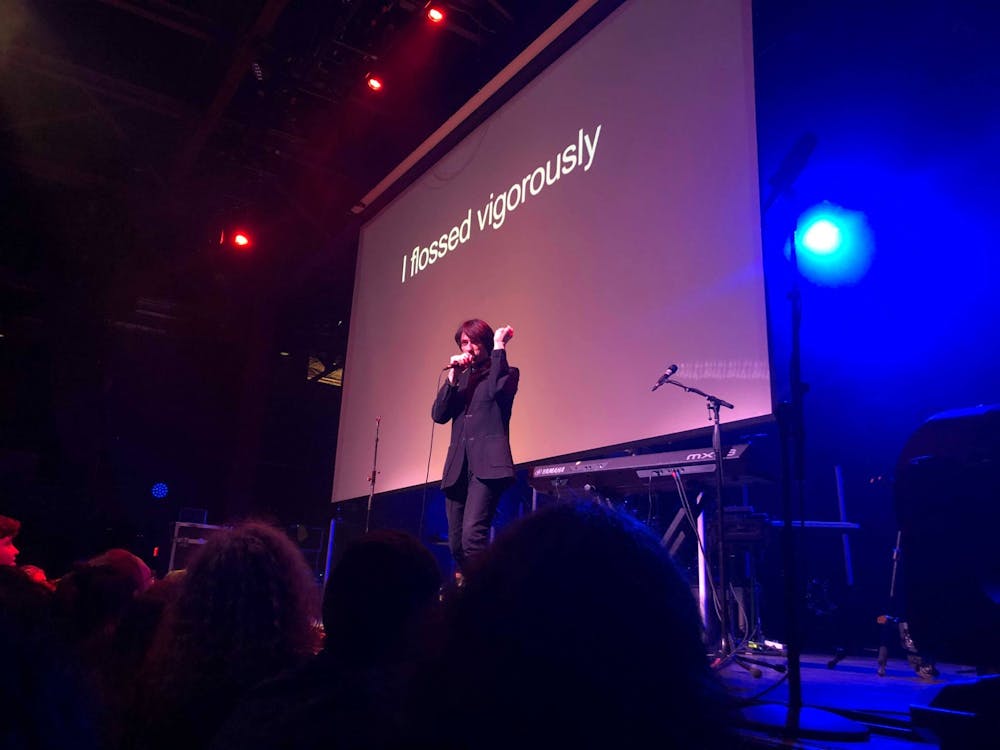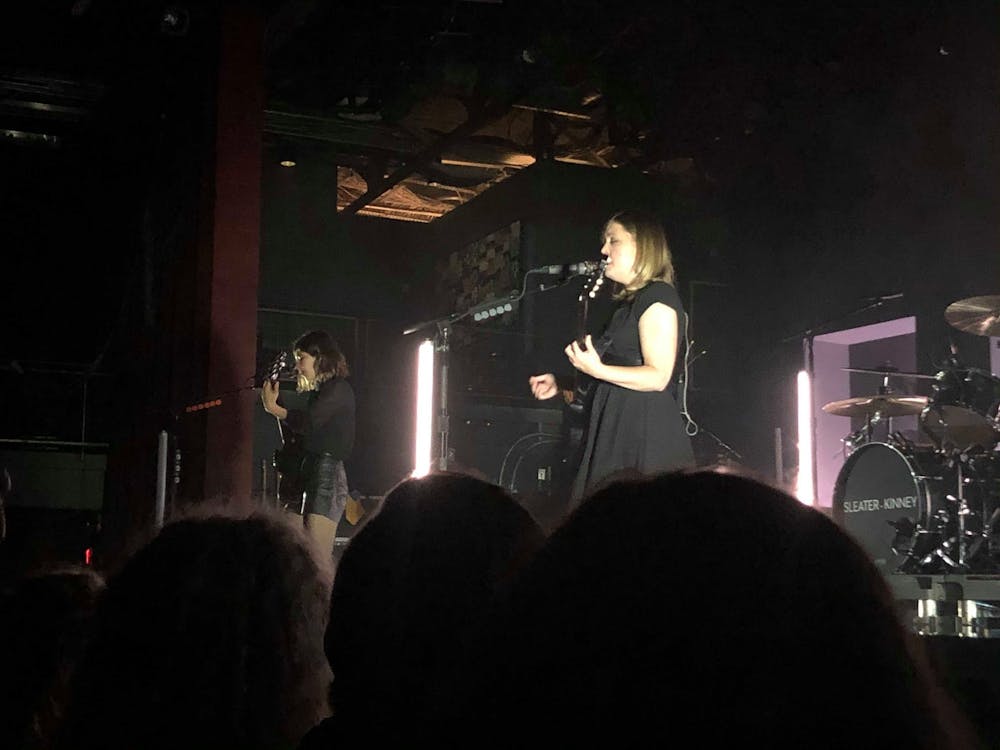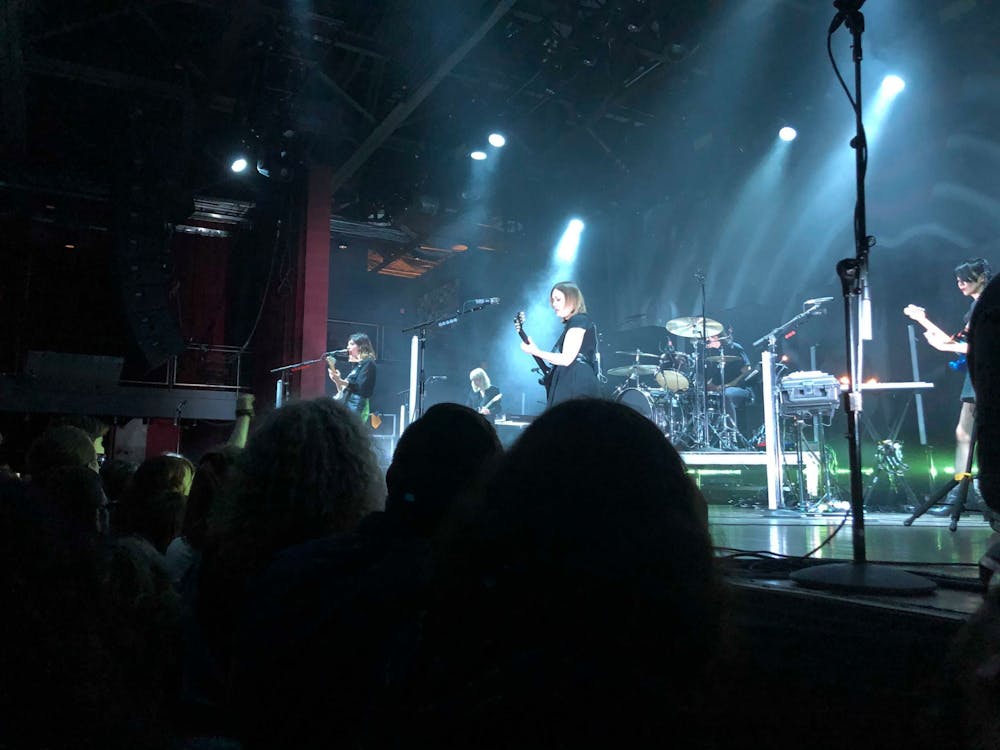This has been the year of the riot grrrl renaissance. Bikini Kill reunited in January to play a handful of shows in the United States and England, Team Dresch began a co–headlining tour with Screaming Females earlier this year, and Sleater–Kinney visited the Fillmore on Oct. 27 in support of their newest album, The Center Won’t Hold. The shredding guitar work of dual leads Corin Tucker and Carrie Brownstein and their vicious, snarled vocals formed a classic Sleater–Kinney sound, with one key difference.
In July 2019, longtime Sleater–Kinney drummer Janet Weiss announced her departure from the trio on Twitter: “The band is heading in a new direction and it is time to move on.” For a trio that had been so close, the sudden departure of a longtime member could be reason enough to disband, or at least postpone a worldwide tour. Instead, Tucker and Brownstein decided the show would go on, and embarked on tour not with Weiss, but with a trio of touring members. Even without Weiss, the trademark Sleater–Kinney sound was in full force, appeasing the hordes of riot grrrls who turned out to the Fillmore.
Before Sleater–Kinney took the stage, fans were exposed to an unusual opening act. Eighteen minutes after his set was scheduled to start, a pale, scrawny man with a jet–black bowl cut waltzed onto the stage, dressed in all black. He looked not unlike Neil Gaiman with his hair straightened. “How are we tonight? How was everyone’s day?” He asked, voice like a radio announcer. “Bad? I had a bad day too. Every day, I ask myself, have I ever had a worse day? And then I remember…” He hit a button on his laptop, beginning the music, and he began to sing, in operatic Italian, about the Great Shroom Trip of 2007.

Subtitles flashed behind him on a projector, allowing the audience to keep up with this story and a few more. One song he performed had a full music video, where the protagonist leaves his dead–end desk job and purchases all the clothing of his teen goth phase. In another, he discovers that a girlfriend who once referred to him as “Baby Potato” has been seeing another man, this one nicknamed “Baby Zebra.” The set was performed in a combination of Italian, German, and English, with different voices employed for different characters.
At no point, during his set or Sleater–Kinney’s, was his name mentioned. His shirt at the merch table, which showed a screen cap from music video for “Goth Song,” was labeled “Opener Tee.” The closest the audience came to a name was at one point during “Shroom Trip Opera Italiano,” when the demons in the song say “Hi, Brian!” The internet suggests that he goes by Joseph Keckler.
Joseph Keckler’s greatest accomplishment was, of course, making the headliners seem tame. Both Tucker and Brownstein’s vocals were rough and growly, a choice that Tucker revealed was intentional in a riot grrrl documentary: not only did it suit the band’s message, but the sound forced the listener to pay greater attention. Brownstein usually took on lead guitar duties, and they compensate for the lack of a bassist by tuning their guitars down a step and a half and augmenting their tone with necessary pedals. Combined, the snarling vocals and loud, angry instrumentals are either loved or hated, no in–between.

Great bands are made on the dynamic between the vocalist and their lead guitarist. Think of Pete Townshend and Roger Daltrey, Robert Plant and Jimmy Page, Greg Graffin and Brett Gurewitz. Sleater–Kinney is built on the easy chemistry between Tucker and Brownstein as both trade off vocals and riffs. At no point were all eyes on one of the two—instead, they constantly flickered between them as one barked and the other shredded.
Brownstein played unhinged to Tucker’s restrained. While the former danced and pranced around the stage, thrashing on her guitar and occasionally leaning her head on Tucker’s shoulder, the latter stuck mostly to her microphone. Even their outfits showed the discrepancy: Tucker wore a plain black dress with flats, while the fishnets under Brownstein’s leather skort were ripped, and both her hair and lipstick were mussed and smeared beyond repair by the end of the show.
Although the backing instrumentalists were critical to the sound of Sleater–Kinney’s set, they were irrelevant as far as the performance was concerned. All focus was solely on Tucker and Brownstein as they sang and played for nearly two hours in a set that covered the full scope of their discography. It was almost as if there was an invisible barrier between the two main band members and the trio they brought on tour with them: This was Sleater–Kinney, not Sleater–Kinney and friends.

The band played a marathon set, with no members falling prey to the “questionable kombucha” that all but Brownstein apparently drank during dinner. After 22 songs, the band concluded its main set. A few crew members rearranged the set and placed a keyboard onstage, and Brownstein and Tucker returned for a stripped–down performance of “Broken.” The rest of the band returned for three more songs, concluding with “Modern Girl,” all fists raised in the air as the audience shouted back “My whole life / is like a picture of a sunny day.”
Once the band departed again, the audience looked towards each other in nervous anticipation. The house lights were still down, there were still guitars on stage, and Sleater–Kinney had performed second encores at other tour stops. Sure enough, after sufficient clamor, the band took the stage for the third time, performing two more songs. In total, the set lasted nearly two hours and 28 songs, but for the riot grrrls, modern girls, and punk rockers in the crowd, it would never be enough.

